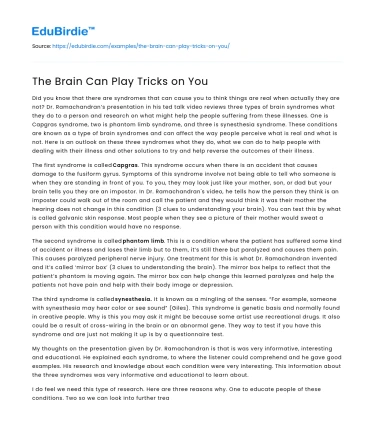Did you know that there are syndromes that can cause you to think things are real when actually they are not? Dr. Ramachandran’s presentation in his ted talk video reviews three types of brain syndromes what they do to a person and research on what might help the people suffering from these illnesses. One is Capgras syndrome, two is phantom limb syndrome, and three is synesthesia syndrome. These conditions are known as a type of brain syndromes and can affect the way people perceive what is real and what is not. Here is an outlook on these three syndromes what they do, what we can do to help people with dealing with their illness and other solutions to try and help reverse the outcomes of their illness.
The first syndrome is called Capgras. This syndrome occurs when there is an accident that causes damage to the fusiform gyrus. Symptoms of this syndrome involve not being able to tell who someone is when they are standing in front of you. To you, they may look just like your mother, son, or dad but your brain tells you they are an impostor. In Dr. Ramachandran's video, he tells how the person they think is an imposter could walk out of the room and call the patient and they would think it was their mother the hearing does not change in this condition (3 clues to understanding your brain). You can test this by what is called galvanic skin response. Most people when they see a picture of their mother would sweat a person with this condition would have no response.
Save your time!
We can take care of your essay
- Proper editing and formatting
- Free revision, title page, and bibliography
- Flexible prices and money-back guarantee
The second syndrome is called phantom limb. This is a condition where the patient has suffered some kind of accident or illness and loses their limb but to them, it’s still there but paralyzed and causes them pain. This causes paralyzed peripheral nerve injury. One treatment for this is what Dr. Ramachandran invented and it’s called ‘mirror box’ (3 clues to understanding the brain). The mirror box helps to reflect that the patient’s phantom is moving again. The mirror box can help change this learned paralyzes and help the patients not have pain and help with their body image or depression.
The third syndrome is called synesthesia. It is known as a mingling of the senses. “For example, someone with synesthesia may hear color or see sound” (Giles). This syndrome is genetic basis and normally found in creative people. Why is this you may ask it might be because some artist use recreational drugs. It also could be a result of cross-wiring in the brain or an abnormal gene. They way to test if you have this syndrome and are just not making it up is by a questionnaire test.
My thoughts on the presentation given by Dr. Ramachandran is that is was very informative, interesting and educational. He explained each syndrome, to where the listener could comprehend and he gave good examples. His research and knowledge about each condition were very interesting. This information about the three syndromes was very informative and educational to learn about.
I do feel we need this type of research. Here are three reasons why. One to educate people of these conditions. Two so we can look into further treatments for people suffering from these conditions. Three to help follow-through with treatment or a cure.
The syndrome I found the most interesting was the Phantom limb. The reason I picked this one is because I have known people that have experienced this condition. It was always interesting yet confusing when they would say my foot is hurting but there is no foot there. I always figured it was the mind playing tricks on them. This presentation helped me to understand this syndrome a little bit better. I was not really sure of anything I could suggest on research for these syndromes.
Works Cited
- Ramachandran, Dr. Vilayanur. 3 Cluesthesederstanding Your Brain, Ted talks, 2007, Https://Www.ted.com/Talks/vs_ramachandran_3_clues_to_understanding_your_brain/Transcript#t-31754
- Giles, Chrissie. “What It's like to Have Synesthesia: Meet the Man Who Can Taste Sounds.” The Independent, Independent Digital News and Media, 16 Oct. 2017, https://www.independent.co.uk/news/long_reads/synaesthesia-sound-taste-health-science-brain-a7996766.html
Did you like this example?
Make sure you submit a unique essay
Our writers will provide you with an essay sample written from scratch: any topic, any deadline, any instructions.
Cite this paper
-
APA
-
MLA
-
Harvard
-
Vancouver
The Brain Can Play Tricks on You.
(2022, September 01). Edubirdie. Retrieved December 22, 2024, from https://edubirdie.com/examples/the-brain-can-play-tricks-on-you/
“The Brain Can Play Tricks on You.” Edubirdie, 01 Sept. 2022, edubirdie.com/examples/the-brain-can-play-tricks-on-you/
The Brain Can Play Tricks on You. [online].
Available at: <https://edubirdie.com/examples/the-brain-can-play-tricks-on-you/> [Accessed 22 Dec. 2024].
The Brain Can Play Tricks on You [Internet]. Edubirdie.
2022 Sept 01 [cited 2024 Dec 22].
Available from: https://edubirdie.com/examples/the-brain-can-play-tricks-on-you/
copy






 Stuck on your essay?
Stuck on your essay?

